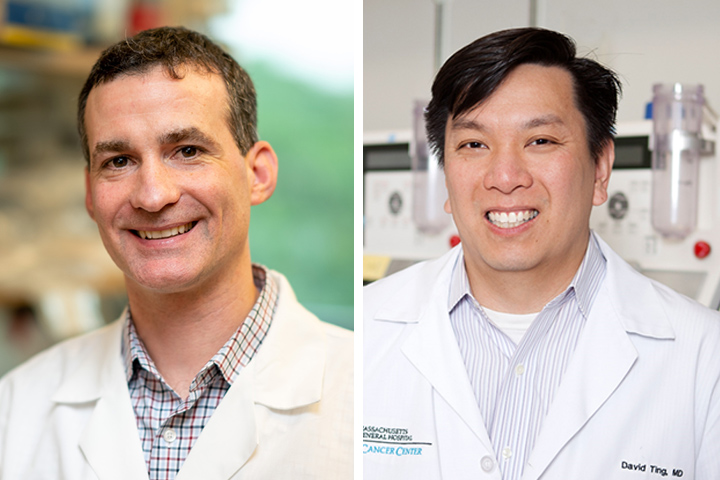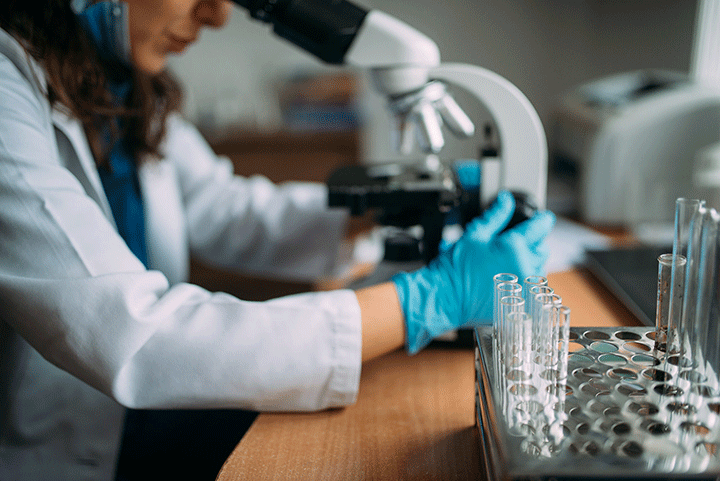Tumor Subtypes Potentially Provide Clues About Prognosis and Treatment

Pancreatic cancer researchers all share a common goal: they want to turn the disease from one of the most lethal of cancers into one that is more treatable.
In the labs of Andrew Aguirre, M.D., Ph.D., and David Ting, M.D., the mysteries of pancreatic cancer are being unraveled by looking at what are called transcriptional subtypes of the disease, basically how the molecular identities of pancreatic cancers differ from one patient to the next. The ultimate hope is to find ways to more precisely target the best treatment to each individual patient.
“Pancreas cancer is so aggressive that if you don’t choose the right drugs in the first-line setting you miss an opportunity, because patients can accrue toxicity with no real benefit,” says Aguirre, Assistant Professor of Medicine at Harvard Medical School, oncologist at Dana-Farber Cancer Institute (Boston) and Associate Member of the Broad Institute of Harvard and M.I.T.
“Defining markers and subtypes upfront is very important. We need to better understand the biology of pancreas cancer and identify the right molecularly targeted therapies to make precision medicine benefit more patients,” says Ting, Assistant Professor of Medicine, Harvard Medical School and Associate Clinical Director for Innovation, Massachusetts General Hospital (MGH) Cancer Center (Boston).
Two Major Subtypes of Pancreatic Cancer
Pancreatic cancer is typically categorized by its size, location, and whether it has spread to other organs. But recent technologies have allowed many research groups to delve more deeply into the biological foundations of a tumor and to perform very detailed genomic and transcriptional analysis. Very simply, the process of making a copy from our DNA is called transcription. It’s a vital function in making proteins. Our DNA, which is in the form of the familiar double helix, is transcribed or copied into RNA, which then encodes proteins.
Due to ever-evolving technologies, scientists can now take a “big picture” view of the entire process. “Instead of looking at one piece of RNA that is expressed, we’ve been able to look at many RNAs across pancreas cancer,” Aguirre explains. And from those studies, two major fingerprints that highlight two different biologies of pancreatic cancer have emerged.
These “fingerprints” found by RNA-based molecular subtyping are the squamous/basal-like/quasimesenchymal subtype and a classical/pancreatic progenitor subtype, more simply referred to as the basal-like and classical subtypes of pancreas cancer. The identification of these subtypes reflects years of convergent studies from several groups across the world to define clinically meaningful subtypes of this disease.
RNA Subtypes Are Not Necessarily Binary
These so-called subtypes may have significant relevance in terms of a patient’s prognosis as well as providing important clues as to what current treatments or investigative treatments may be most beneficial to patients.
“If you look at a classical type under the microscope it can look well differentiated, and more like glandular tissue,” Aguirre explains. On the other hand, the basal type is less glandular and can be more squamous in character. Those with a classical subtype of pancreatic cancer may have a better overall prognosis compared to a basal-like type, which is considered much more aggressive, he adds.
Some research groups have tried to distill these subtypes down to a few genes so a standard assay could be performed, which could, in theory, provide doctors with information more rapidly. One gene being looked at, for example, is GATA6. GATA6 is a transcription enzyme, and in a trial led by Dr. Jennifer Knox (at Princess Margaret Cancer Centre, Toronto) and colleagues in Canada, the basal-like tumors, which were GATA6-low, were found to be particularly resistant to mFOLFIRINOX, a standard treatment. Other biomarkers being studied include Keratin 17 and p63.
“In my lab we’ve taken these observations from genome sequencing studies and are trying to understand what is unique about these subtypes in order to identify molecular vulnerabilities that can lead to new therapies,” Aguirre says.
One thing that physician–scientists like Aguirre and Ting are learning is there is an “interconversion” between the subtypes. Basically, a pancreas tumor can have cells expressing both basal-like and classical signatures. “We’ve seen this in metastatic and in primary specimens,” Aguirre says. Also, under certain selective pressure like chemotherapy, for example, a tumor can be classical and then become basal-like, he adds.
“There is a real need to understand how a tumor evolves over time,” says Ting. “We need to know what molecular changes occur in different states such as when a tumor metastasizes or after we have given certain therapies.”
In his lab at MGH, Ting is using RNA-sequencing and RNA in situ hybridization technologies to better understand the very complex transcriptional landscape of pancreatic cancer. “At times we have a tendency in clinical medicine to think of things in a binary way,” he says. “In reality, there is likely to be far greater complexity. Rather than classical or basal-like tumors, each tumor is actually somewhere on a spectrum with these two phenotypes at each end of the scale. Is it classical or basal? In biology, we’re learning it’s really not one or the other.”
To further confound matters, basal-like and classical cells can coexist at the same time in a pancreatic cancer tumor. Or a tumor may change after treatment. This change, for example, is one way the cancer cell “tries to avoid dying,” says Ting. “They are dynamic and able to adapt, and that’s much of the focus of the research we are working on. How do you stop tumors from being so adaptable and prevent pancreatic cancer from being so resistant to therapy.”
How Patients May Benefit
In the clinical context, can this evolving knowledge about subtypes be useful? Ting believes the answer to that question is a resounding “yes.” He is developing an assay that could identify not only the subtypes of a pancreatic tumor quickly and then adjust drug regimens of standard and investigative treatments upfront. Although the research behind the technology is very complex, the process itself would be similar to that of a pathologist viewing a slide under a microscope. “They’ve been doing similar things in breast cancer for three decades and I feel this is our moment to do this for pancreatic cancer,” Ting says.
Both Ting and Aguirre agree that pancreatic cancer does indeed need that breakthrough moment. Both were exposed to the disease early in their careers. “As a clinician and a scientist I learn a lot from my patients,” Aguirre says. “The patients are absolutely at the center of my research. The bar is set very high to do something impactful with this disease. I tell the people in my lab all the time that what they are doing is important, even though it can be challenging. If we all take steps collectively we can have a meaningful effect on the lives of pancreas cancer patients.”
Ting was a third-year medical student when he first encountered pancreatic cancer in a patient. It was that patient who set Ting down a path of researching and treating pancreatic cancer. “I get very impatient on behalf of our patients,” Ting says. “Statistically, pancreas cancer is still one of the worst cancers you can get. When I started doing this 10 years ago there were just a handful of people working on it. Now there are a lot more of us.”
“While the science itself is fascinating, we have a chance now to shift the standard of care. Together we can change the narrative of patients with pancreas cancer. We owe it to the patients.”






